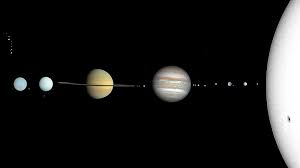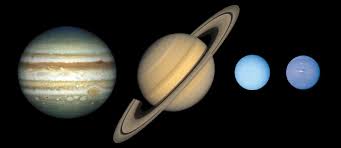The Marvel of Planetary Systems
Planetary systems are among the most fascinating structures in the universe. These intricate arrangements of planets, moons, asteroids, and other celestial bodies orbiting a central star are key to understanding how the cosmos organizes itself. The study of planetary systems not only provides insights into the formation and evolution of our own solar system but also sheds light on the potential for life beyond Earth.
The Nature of Planetary Systems
Contents
- 1 The Nature of Planetary Systems
- 1.1 The Formation of Planetary Systems
- 1.2 The Structure of Planetary Systems
- 1.3 The Role of Gravity
- 1.4 The Discovery of Exoplanetary Systems
- 1.5 The Habitability of Planetary Systems
- 1.6 The Role of Moons in Planetary Systems
- 1.7 The Dynamics of Planetary Systems
- 1.8 The Influence of Binary and Multiple Star Systems
- 1.9 The Importance of Small Bodies in Planetary Systems
- 1.10 The Future of Planetary System Exploration
- 1.11 The Cosmic Significance of Planetary Systems
- 1.12 Conclusion
- 2 Author

A planetary system consists of a star and the objects gravitationally bound to it. These objects typically include planets, moons, comets, asteroids, and dust. The star serves as the system’s centerpiece, providing the gravitational anchor that keeps the system intact.
The diversity of planetary systems is staggering. Observations of exoplanets—planets outside our solar system—have revealed configurations vastly different from our own, challenging preconceived notions about planetary formation and dynamics.
The Formation of Planetary Systems
Planetary systems form from the remnants of giant molecular clouds, which collapse under gravity to create protostars. Surrounding these young stars are rotating disks of gas and dust, known as protoplanetary disks.
Within these disks, particles collide and stick together, forming planetesimals—the building blocks of planets. Over time, these planetesimals grow through accretion, eventually forming protoplanets. The composition of these planets depends on their distance from the star and the materials available in the disk.
Closer to the star, rocky planets form due to the high temperatures that prevent volatile compounds from condensing. Farther out, gas giants and ice giants dominate, accumulating massive atmospheres from the surrounding gas.
The Structure of Planetary Systems
The structure of a planetary system depends on the dynamics of its formation and the gravitational interactions among its members. Common features include:
- Rocky Inner Planets: These are typically smaller and composed of silicate rocks and metals. In our solar system, Earth, Venus, Mercury, and Mars fall into this category.
- Gas Giants: Located farther from the star, these planets, like Jupiter and Saturn, have massive atmospheres dominated by hydrogen and helium.
- Ice Giants: Planets such as Uranus and Neptune feature atmospheres rich in water, ammonia, and methane, along with icy cores.
- Asteroid Belts: Regions of rocky debris, such as the asteroid belt between Mars and Jupiter, form from leftover material that never coalesced into planets.
- Kuiper Belt and Oort Cloud: These outer regions are populated with icy bodies, comets, and dwarf planets.
The Role of Gravity

Gravity is the dominant force shaping planetary systems. It governs the orbits of planets, moons, and smaller bodies, creating a dynamic interplay that ensures the system’s stability—or leads to chaos.
Gravitational interactions can result in phenomena such as planetary migration, where planets move from their original positions, and resonances, where orbital periods of celestial bodies are harmonized. These processes have profound effects on the configuration and evolution of planetary systems.
The Discovery of Exoplanetary Systems
The discovery of exoplanetary systems has revolutionized our understanding of planetary systems. The first confirmed exoplanet, found in 1992, opened the door to a new era of exploration. Since then, thousands of exoplanets have been discovered, with missions like Kepler and TESS leading the charge.
These discoveries have revealed an astonishing variety of planetary systems. Hot Jupiters—gas giants orbiting close to their stars—challenge traditional models of planet formation. Super-Earths and mini-Neptunes represent classes of planets not found in our solar system, expanding the possibilities of planetary diversity.
The Habitability of Planetary Systems
One of the most compelling aspects of studying planetary systems is the search for habitable environments. Planets within the “habitable zone” of their stars, where temperatures allow liquid water to exist, are prime candidates for supporting life.
Factors influencing habitability include the planet’s size, atmosphere, magnetic field, and geological activity. The presence of moons, which can stabilize a planet’s tilt and climate, also plays a significant role.
While Earth remains the only known habitable planet, the discovery of potentially habitable exoplanets fuels the hope of finding life beyond our solar system.
The Role of Moons in Planetary Systems
Moons, or natural satellites, are critical components of planetary systems. They vary widely in size, composition, and geological activity. Some moons, such as Jupiter’s Io and Europa, exhibit extreme volcanic activity or subsurface oceans, making them intriguing targets for astrobiological studies.
The presence of large moons, like Earth’s Moon, can influence a planet’s climate and stability. For example, the Moon helps stabilize Earth’s axial tilt, creating predictable seasons that are conducive to life.
The Dynamics of Planetary Systems

Planetary systems are not static; they are dynamic environments shaped by ongoing interactions. Collisions between celestial bodies, gravitational perturbations, and stellar activity continually reshape these systems.
Asteroids and comets, remnants of planetary formation, occasionally collide with planets, delivering water and organic compounds. Such events may have played a crucial role in the development of life on Earth.
Stellar activity, including flares and solar wind, can strip latoto away planetary atmospheres, affecting the potential for habitability. Understanding these dynamics is essential for comprehending the long-term evolution of planetary systems.
The Influence of Binary and Multiple Star Systems
Many stars exist in binary or multiple star systems, where two or more stars orbit each other. These complex arrangements influence the formation and stability of planetary systems.
Planets in binary systems can have stable orbits if they are either close to one star or far enough from the binary pair. However, the gravitational interplay between the stars can disrupt planetary orbits, leading to chaotic dynamics or ejections.
The discovery of planets in binary systems, such as Kepler-16b, demonstrates the resilience of planetary formation under diverse conditions.
The Importance of Small Bodies in Planetary Systems
Asteroids, comets, and dwarf planets are often overlooked but play significant roles in planetary systems. These small bodies provide insights into the early stages of planetary formation, as they are relatively unchanged since the system’s birth.
Comets, in particular, are thought to have delivered water and organic molecules to Earth, contributing to the emergence of life. Their icy compositions also make them valuable resources for future space exploration.
Dwarf planets, like Pluto, highlight the diversity of objects in planetary systems and challenge traditional definitions of planets.
The Future of Planetary System Exploration
The exploration of planetary systems is entering an exciting era. Upcoming missions and advanced telescopes promise to unveil more about the nature and diversity of these systems.
The James Webb Space Telescope aims to study exoplanetary atmospheres, searching for biosignatures and other indicators of habitability. Future missions to icy moons, such as Europa Clipper, will investigate the potential for life in subsurface oceans.
The development of space telescopes capable of imaging Earth-like exoplanets directly will revolutionize our ability to study planetary systems. These advancements will deepen our understanding of the universe and our place within it.
The Cosmic Significance of Planetary Systems
Planetary systems are more than just celestial arrangements; they are microcosms of the universe’s creativity and complexity. They demonstrate the intricate balance of forces and processes that shape the cosmos.
Studying planetary systems not only expands our scientific knowledge but also inspires a sense of wonder and curiosity. They remind us of the interconnectedness of the universe and the possibility that life may exist beyond our small corner of space.
Conclusion
Planetary systems represent the harmonious interplay of celestial forces and the boundless diversity of the cosmos. From their formation in protoplanetary disks to the discovery of exoplanets and the search for habitability, these systems are a testament to the universe’s intricate design. As exploration continues, the study of planetary systems promises to uncover new wonders and deepen our understanding of the universe, offering a glimpse into the possibilities of life beyond Earth.














